Indexed In
- Open J Gate
- Genamics JournalSeek
- JournalTOCs
- China National Knowledge Infrastructure (CNKI)
- Electronic Journals Library
- RefSeek
- Hamdard University
- EBSCO A-Z
- OCLC- WorldCat
- SWB online catalog
- Virtual Library of Biology (vifabio)
- Publons
- MIAR
- Euro Pub
- Google Scholar
Useful Links
Share This Page
Journal Flyer

Open Access Journals
- Agri and Aquaculture
- Biochemistry
- Bioinformatics & Systems Biology
- Business & Management
- Chemistry
- Clinical Sciences
- Engineering
- Food & Nutrition
- General Science
- Genetics & Molecular Biology
- Immunology & Microbiology
- Medical Sciences
- Neuroscience & Psychology
- Nursing & Health Care
- Pharmaceutical Sciences
Research Article - (2019) Volume 10, Issue 1
Bioaccumulation of Total Hydrocarbon Content by Three Mangrove Species (Rhizophora, Laguncularia, Avicennia) in the Niger Delta, Nigeria
Numbere AO*Received: 28-Jan-2019 Published: 18-Feb-2019, DOI: 10.35248/2157-7463.19.10.387
Abstract
Bioaccumulation of total hydrocarbon content (THC) in mangrove is a bottom up effect. Leave, root, seed and stem samples were collected from red, black and white mangroves from highly and lowly polluted locations. Total hydrocarbon analysis was done with atomic absorption spectrophotometric method using HARCH DR 890 colorimeter (wavelength~420 nm). The result indicates that there is significant difference in THC between species (F2, 105=9.82, P<0.001) and parts (F3, 104=7.82, P<0.001) of mangroves. Red mangroves had the highest bioaccumulation of THC as compared to black and white mangroves (Tukey test, α=0.05). Leaves had the highest concentration of THC in the order of leave>seed>root>stem. For red mangroves THC ranged from 0.47 mg/l in root to 25.38 mg/l in the leave, for white mangroves THC ranged from 1.08 mg/l in stem to 5.90 mg/l in leave; for black mangrove THC ranged from 1.08 mg/l in stem to 21.64 mg/l in seed in the lowly polluted location while in the highly polluted location for red mangroves THC varied from 1.08 mg/l in stem to 23.97 mg/l in leave, for white mangroves THC varied from 0.64 mg/l in stem to 4.32 mg/l in leave and for black THC varied from 1.31 mg/l to 6.17 mg/l in leave. Mangrove parts in lowly polluted location had higher mean THC (10.43 ± 1.74 mg/l) than plant parts in highly polluted location (5.21 ± 0.62 mg/l). This study implies that red mangroves are good pollutant sink, which makes them a good bioremediation agent. Contamination of mangrove can lead to biomagnification of hydrocarbon up the food chain.
Keywords
Hydrocarbon pollution; Rhizophora species; Mangroves; Biomagnification; Bottom up; Food chain
Introduction
Mangroves are often described as resilient [1] and persistent [2] to external perturbations such as changes in tidal surge, high salinity, low oxygen [3] and hydrocarbon pollution [4]. Mangroves can survive low to medium oil spillages and sometimes major spillages. This is because of their adaptation to grow in difficult and polluted environment. Mangrove forest encounters numerous natural (e.g., tsunami, global warming, and hurricane) and anthropogenic (e.g., invasive species, hydrocarbon pollution and deforestation) effects. The reason for these impacts is because of their growth in the interface between the land and the sea. They are the source and sink of heavy metals and hydrocarbons that flow from land and sea [5,6]. Mangroves are complex and are biodiversity hotspot [7], and provide over 30 ecosystem services [8]. The ability of heavy metals and hydrocarbons to circulate within mangrove environment has been studied [9]. Similarly, total hydrocarbons and heavy metals can be transferred from the root to the leaves of mangroves [10]. Organic pollutants can biodegrade because of multiplicity of microbial activities in the mangrove forest [11]. Mangrove ecosystem is rich in organic material, but deficient in nutrient, especially nitrogen and phosphorus. However, nitrifying bacteria are helping to accelerate mineralization of molecular nitrogen or nitrous oxide from ammonia which is derived from plant litter. Hydrocarbons can also serve as an antiseptic agents that reduce microbes and disease-causing agents in mangrove forest [12]. This can lead to robust growth of mangroves under conditions of high hydrocarbon pollution as compared to mangroves forest in a less polluted environment. In the same vein hydrocarbon utilizing bacteria can degrade some hydrocarbons in the mangrove forest. However, many toxic heavy metals and hydrocarbons cannot biodegrade and will persist in the forest for a long time to bioaccumulate in living organisms and be transferred up the food chain [13]. Mobility of heavy metals and hydrocarbons from mangroves soil to the mangrove plant has been described [14]. These metals cannot be degraded, and will accumulate in mangrove parts [15]. Mangroves of the Niger Delta are constantly affected by hydrocarbon pollution because of the activities of oil and gas exploration, which has led to numerous oil spillages [4]. This study is based on the most dominant species of mangroves in the Niger Delta, Nigeria i.e., red, black and white mangroves. The red mangrove (Rhizophora mangle) is the tallest of all local species of mangroves in the Niger Delta. It grows to heights over 25 m. It has large broad leaves that grow to 12 cm and terminate with a blunt point. The leaves are waxy, dark green above and pale green below. The trunk and limbs have grey bark that covers a dark red wood. The key characteristics of the red mangrove are the "prop roots" derived from the trunk and “drop roots” from the branches. The seedling or propagule is almost 15 cm and cigar-shaped. The black mangrove (Avicenia germninans) occurs shoreward to the red mangroves and is characterized by the presence of small pencil like vertical root shoots called pneumatophores. These root shots stand in dense arrays near the high tide line, enabling the mangroves to obtain oxygen directly from the air. White Mangroves (Languncularia racemosa) grow on elevated grounds above the high-tide marks and behind the red and black mangroves. The leaves are thick and succulent, rounded at both ends, and the same colour at both ends. The root system resembles that of most terrestrial plants and seldom show breathing roots [16].
Many studies have been carried out on the impact of oil and gas exploration on soil, water and fauna [17-19], but not many studies have been carried out on the accumulation of total hydrocarbon content (THC) in mangrove parts in the Niger delta. This study intends to bridge that knowledge gap by collation of data to estimate the concentration of total hydrocarbon content (THC) in different parts of mangrove species. The study, thus hypothesized that total hydrocarbon content will be transferred from soil to mangrove parts as stated [10]. The objective of this study is therefore, (1) to determine the THC accumulation in different parts of mangroves (2) to determine whether there is significant difference in THC concentration between three mangrove species namely red (Rhizophora racemosa), black (Avicennia germinans) and white (Laguncularia racemosa) mangroves, and (3) to determine the THC concentration in mangrove parts in highly and lowly polluted locations.
Materials and Methods
Description of study area
Okrika sampling site (4°43’N and 7°05’) is close to a major refinery that supplies petrochemical products and crude oil abroad via a jetty (Figure 1). It has rich supply of mangrove forest, which is made up of invasive nypa palm (Nypa fruticans). The mangrove forest in this location is divided into two areas by an access road (~5 wide) running through the middle which leads from the refinery to the jetty. This features created a partitioning of the mangrove forest into two separate regions. Detail description of the study area is found [20].
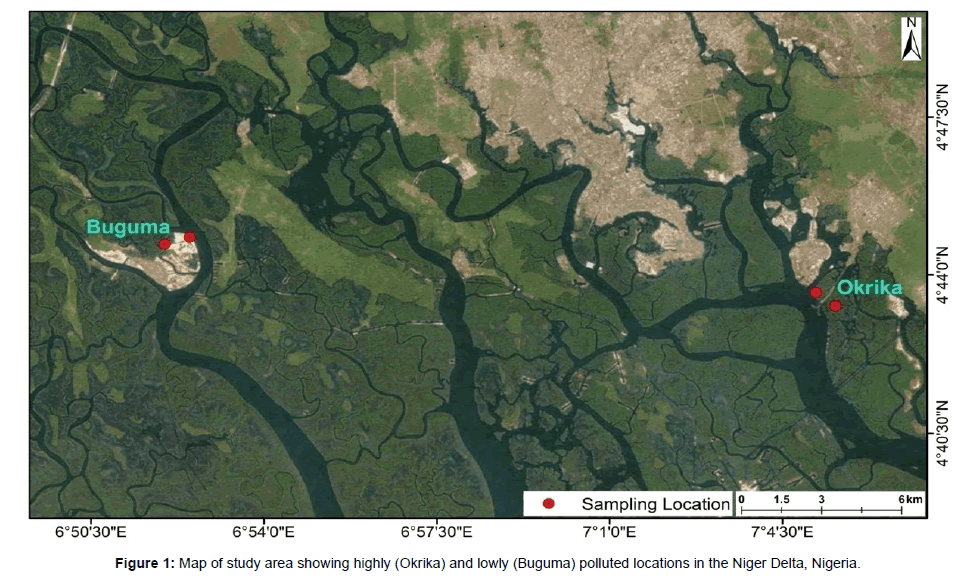
Figure 1: Map of study area showing highly (Okrika) and lowly (Buguma) polluted locations in the Niger Delta, Nigeria.
Buguma, the second study area is a coastal community (4°45’N and 6°53’E) that has rich amount of mangroves forest. It has lesser oil and gas exploratory activity (Figure 1). The sampling site is close to a crude oil well head, which had its last spillage in 2010. It has a large population of red, black and white mangroves.
Sample collection, preparation and laboratory analysis
Mangroves at two locations were sampled: (i) Abbi-Ama in Buguma, and (ii) Refinery jetty at Okrika. The main treatments, which are the two locations, were designated as lowly and highly polluted locations respectively. In each study area, a 20 × 20 m plot was delineated. Within each plot 10 trees were randomly selected. Twenty leaves, seeds, pieces of root, and stem (bark piece) from the three species (red, white and black) of mangroves were plucked, cut or dug out, placed in a cooler and taken to the laboratory for THC analysis. The following soil characteristics were measured: pH, temperature, salinity, THC in soil and water. For the soil analysis, fresh samples were collected in-situ with a soil augur weighed and placed in sterile polythene bags and sent to the lab. For each location 3 replicates from each sampling plot were used for highly and lowly polluted treatments (i.e., 2 × 2 × 3=12).
Total hydrocarbon content
The method of analysis used is the atomic absorption spectrophotometric method using Harch DR 890 colorimeter (wavelength 420 nm). The root, stem and leaves sample were oven dried at 60°C in the drying oven (Memert u 270) for 24 hours to get rid of the moisture. The dried samples were crushed and 2 g of it was weighed into a glass beaker and 2 ml of hexane added. The sample was homogenized with the use of a glass rod by stirring. After that the samples were filtered through a glass funnel packed with cotton wool, silica gel, anhydrous sodium sulphate. After the filtration, 10 ml of the filtered organic extract was transferred into 10 ml sample covet and inserted into the colorimeter. Total hydrocarbon content was expressed in ppm which is an equivalent to mg/l.
Statistical analysis
Results of the multiple treatments were analyzed with one way Analysis of Variance (ANOVA) in R environment, and significant ANOVAs were followed up with Tukeys HSD (Honestly Significant Difference) post hoc test for multiple comparisons [21,22]. Bar graphs were plotted to illustrate the significance and differences in THC concentrations [23].
Results
Physico-chemistry of study site
The physico-chemistry of both study sites are given in Table 1. The mean soil pH is 6.56 for Okrika and 6.60 for Buguma, which are acidic to neutral. The salinity level is slightly higher in Okrika (24.2 ppm) than Buguma (21.7 ppm). Temperature for both sites ranges from 27-30°C. Soil THC was higher than water THC for both locations. THC for both soil and water was higher in highly polluted soil than lowly polluted soil.
| Location | Mean pH | Mean salinity (ppm) | Mean Temp (°C) | Soil THC | Water THC |
|---|---|---|---|---|---|
| Okrika | 6.56 ± 1.2 | 24.2 ± 0.2 | 27.3 ± 0.3 | 130.55 ± 1.91 | 11.40 ± 1.21 |
| Buguma | 6.60 ± 0.1 | 21.7 ± 0.5 | 30.5 ± 0.4 | 52.92 ± 97.9 | 1.40 ± 0.03 |
Table 1: Physicochemical parameters of study location Okrika and Buguma, Niger Delta, Nigeria.
Total hydrocarbon content of plant parts between locations
Hydrocarbon concentration in three Rhizophora species is given in Table 2. They varied significantly between mangrove plant parts and sampling locations. Leaves accumulated high level of THC, while stem did accumulate very low amount. The surprising thing is that the THC recorded was greater in the lowly polluted location (Buguma) than the highly polluted location (Okrika). Amongst the three species red mangroves accumulated the maximum THC in almost all mangrove parts, while white mangroves accumulated the least (Table 2).
| THC Concentration in mangrove species (mg/l) | ||||
|---|---|---|---|---|
| Sample station | Plant part | Red | White | Black |
| Low pollution (Buguma) | Seed | 25.07 ± 0.77c | 0.66 ± 0.02a | 21.64 ± 0.77c |
| Leaf | 25.38 ± 0.46c | 5.90 ± 0.24c | 20.22 ± 0.93c | |
| Stem | 2.31 ± 0.08b | 1.08 ± 0.02b | 1.08 ± 0.02a | |
| Root | 0.47 ± 0.03a | 1.17 ± 0.02b | 1.85 ± 0.49b | |
| High Pollution (Okrika) | Seed | 1.83 ± 0.17a | 1.17 ± 0.34b | 1.49 ± 0.84a |
| Leaf | 23.97 ±2.33b | 4.32 ± 0.65c | 6.17 ± 2.30c | |
| Stem | 1.08 ± 0.08a | 0.64 ± 0.16a | 1.31 ± 0.07a | |
| Root | 1.25 ± 0.11a | 1.19 ± 0.30b | 2.39 ± 0.38b | |
Table 2: Total hydrocarbon concentration (mg/l) in three different mangrove species parts collected from highly (Okrika) and lowly (Buguma) polluted locations in the Niger Delta, Nigeria (values are average of triplicate samples with standard error; dissimilar alphabets are significant at 5% level).
For red mangroves THC ranged from 0.47 mg/l in root to 25.38 mg/l in the leave, for white mangroves THC ranged from 1.08 mg/l in stem to 5.90 mg/l in leave and for black mangrove THC ranged from 1.08 mg/l in stem to 21.64 mg/l in seed in the lowly polluted location (Buguma) while in the highly polluted site (Okrika) THC varied from 1.08 mg/l in stem to 23.97 mg/l in leave in red, varied from 0.64 mg/l in stem to 4.32 mg/l in leave in white mangrove and varied from 1.31 mg/l to 6.17 mg/l in leave.
The result indicates that there was significant difference in THC between species (i.e., red, black and white) in both study locations (F2, 105=9.82, P<0.001) (Figure 2). The Tukey HSD post hoc test showed that red and black species are the most significantly different at alpha =0.05. There was also significant difference in THC concentration in the parts of mangrove for the three species (F3, 104=7.82, P<0.001) (Figure 3). Root-leaf and stem-leaf are the most significantly different combination at alpha=0.05. The concentration of THC between species and mangrove parts is significant in Okrika (Figure 4) and Buguma (Figure 5).
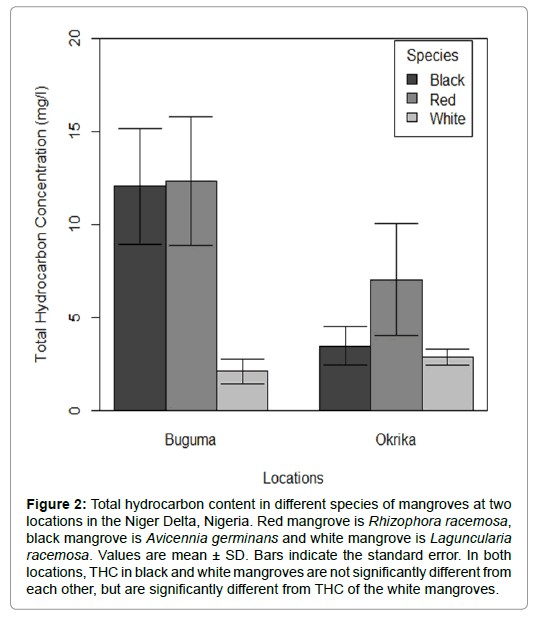
Figure 2: Total hydrocarbon content in different species of mangroves at two locations in the Niger Delta, Nigeria. Red mangrove is Rhizophora racemosa, black mangrove is Avicennia germinans and white mangrove is Laguncularia racemosa. Values are mean ± SD. Bars indicate the standard error. In both locations, THC in black and white mangroves are not significantly different from each other, but are significantly different from THC of the white mangroves.
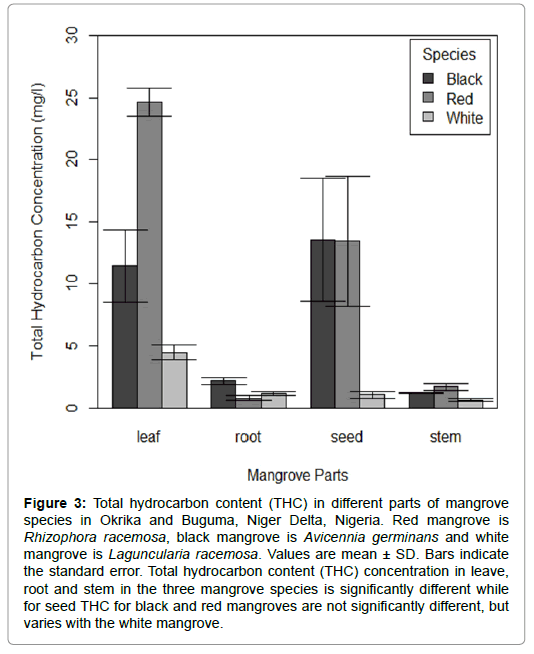
Figure 3: Total hydrocarbon content (THC) in different parts of mangrove species in Okrika and Buguma, Niger Delta, Nigeria. Red mangrove is Rhizophora racemosa, black mangrove is Avicennia germinans and white mangrove is Laguncularia racemosa. Values are mean ± SD. Bars indicate the standard error. Total hydrocarbon content (THC) concentration in leave, root and stem in the three mangrove species is significantly different while for seed THC for black and red mangroves are not significantly different, but varies with the white mangrove.
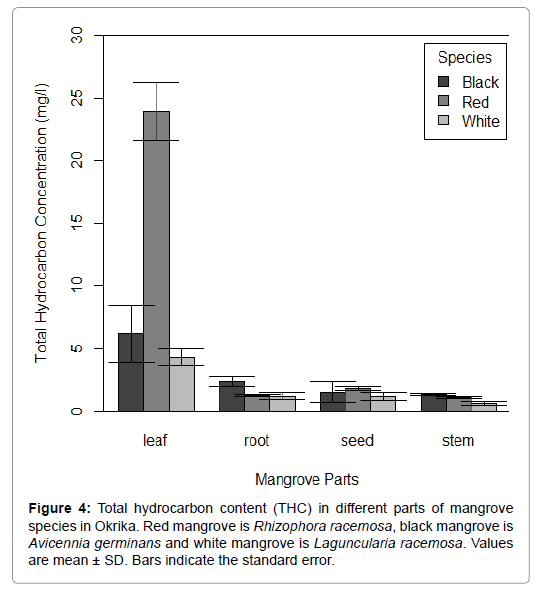
Figure 4: Total hydrocarbon content (THC) in different parts of mangrove species in Okrika. Red mangrove is Rhizophora racemosa, black mangrove is Avicennia germinans and white mangrove is Laguncularia racemosa. Values are mean ± SD. Bars indicate the standard error.
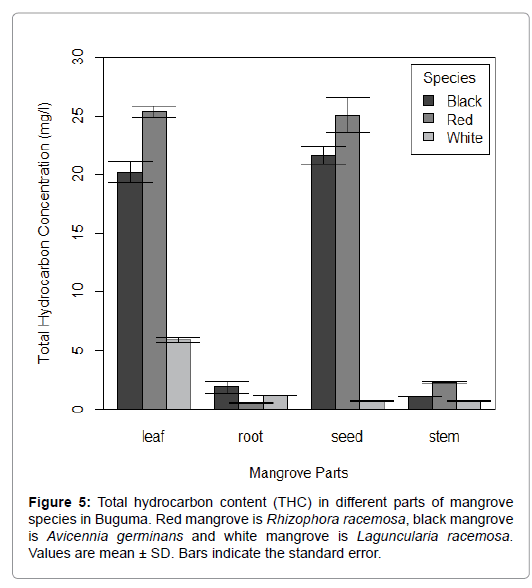
Figure 5: Total hydrocarbon content (THC) in different parts of mangrove species in Buguma. Red mangrove is Rhizophora racemosa, black mangrove is Avicennia germinans and white mangrove is Laguncularia racemosa. Values are mean ± SD. Bars indicate the standard error.
Discussion
There was high concentration of THC in mangrove leave as compared to other parts because the leaves serve as excretory organ for expelling toxic materials absorbed from the soil [10]. This occurs through yellowing and defoliation of leaves that have high concentration of pollutants. Other parts of the plant like the stem, seed and root do not have the property of falling off from the mangrove tree as often as the leaves. However, the seeds fall off during the reproductive cycle of the plant. The same principle of litter fall is applied in reducing the effect of high salinity in mangrove cells [24]. Mangroves use three methods to overcome the effect of its high salinity. This include (1) excretion of salt crystals from mangrove leaves, (2) senescence and defoliation of leaves, and (3) shut down mechanism of the root to prevent excess absorption of salt. The ability of mangroves to absorbing substances from the soil to the leaves is a bottom up mechanism and has been described [10]. There was higher THC in root samples in highly polluted site than lowly polluted site, which may interfere with its salt intake ability and result to a trade off by causing more restriction in the intake of excess hydrocarbons into plant leaves (Table 2). Petroleum hydrocarbons induce stress in salt-extracting plants such as the mangroves, by disrupting the ability of the roots to exclude ions from sea or brackish waters [25]. There is also an uptake of total hydrocarbons by other media in mangrove forest, for example the uptake of total hydrocarbons by periwinkles (Tympanotonus fuscatus and Pachymelania aurita), which had been studied by other researchers in Bonny River, Niger delta [26]. Periwinkles are hard shelled organisms that dwell on mangrove floor. This study revealed that THC concentration was higher in the shell than in the tissues. The researchers indicated that hydrocarbon pollution is caused by oil spillage and industrial and domestic waste dumped in creeks. Crude oil in the soil may reduce sediment porosity and gaseous exchange that in turn may have a negative effect on the physiological function of the plant [27,28], which may include its pollutant absorption capability. For instance, salinity being a mangrove stressor in estuaries is responsible for changes in adsorption process of metals [29]. This is in line with previous studies that showed high accumulation of heavy metals (Copper and Zinc) in roots followed by leaves and stems in Rhizophora mucronata [30,31]. In contrast, another study showed higher concentration of Copper and Zinc in stems followed by roots and leaves [32]. This study indicates that red mangrove parts have higher THC concentration than black and white mangroves. This is because the red mangroves have better ability of sustaining pollutants within its parts than other species. This is because red mangroves have natural ability to act as a sink of anthropogenic and industrial pollutants [33]. In the same vein, mangrove ecosystem retains toxic metals and stops it from infiltrating into the marine ecosystems. The metal concentrations in mangrove sediment, along with their bioavailability and bioaccumulation in tissues were studied by several workers [33,34]. This is the reasons why red mangroves are found in low saline environment close to the river as compared to the black (Avicennia germinans) and white (Laguncularia racemosa) mangroves that are found in highly saline environment at upland region [35]. Previous studies had also shown that red mangroves (Rhizophora spp.) are less sensitive to oil contamination than black mangroves (Avicennia germinans) [36]. This outcome is in line with this study that showed that white mangroves were the least accumulators of THC (Table 2), which may be a trade-off with their tolerance for high salinity. This is because pollution reduces pH level [37] there by making the soil to be more acidic and less alkaline. Seeds were the next mangrove parts with the highest concentration of THC. This is because they are made up of nitrogen and other food nutrients that are absorbed from the soil. In a polluted environment pollutants can escape with nutrients and lodge within the seeds. The red mangrove seeds had a higher concentration of THC as compared to the black and white mangrove seeds (Table 2). The red mangrove has the largest seed size and larger surface areas as compared to the black and white mangroves. This may contribute to its THC storage capacity. Black mangroves are the next in terms of THC concentration while white mangroves are the least in THC absorption. This pattern may be due to size relationship, but require further investigation to verify. Lewis M studied the effects of crude oil on mangrove seedlings survival and found out that 96.4% of the seedlings died within 14 days after being exposed to the pollutant [33]. Oil contamination can also lead to mutation and deformity of mangrove seeds [38]. A typical example is the discovery of seeds of red mangroves (Rhizophora racemosa) that have two buds rather than one in Buguma, which is due to mutation as a result of hydrocarbon pollution [4].
Conclusion and Recommendations
This study showed that higher productivity and litter fall in red mangroves is a mechanism to counter the effect of total hydrocarbon pollution in a polluted mangrove forest. In line with this ability, red mangroves seedlings can be used for bioremediation of polluted site since they serve as sink to pollutants. High THC in seeds of mangrove can lead to mutation and poor growth of mangrove. The consumption of red mangrove seeds by the West African Red mangrove crabs (Goniopsis pelii) portends danger for other organisms in the food chain due to biomagnification of metals, which might be inimical to human health if consumed. Future studies will consider the relationship of THC concentration in mangrove parts to soil THC, as well as other organisms in the food chain e.g., crabs, periwinkle and fish that feed on mangrove litter on forest floor. This study is significant because it provides data for bio-monitoring of THC concentration in mangrove parts and other forest dwelling organisms to prevent increase in toxicity level that is inimical to humans if they feed on sea food.
Acknowledgements
I wish to specially than my research assistant, Mr. Chimezie Brown and my project student Chinedu Obanye of class 2012 set of the Department of Animal and Environmental Biology, University of Port Harcourt.
REFERENCES
- Alongi DM. Mangrove forest:resilience, protection from tsunamis, and responses to global climate change. Estuar Coast Shelf Sci. 2008;76:1-13.
- Boesch DF. Diversity, stability and response to human disturbance in estuarine systems. Proceedings of the first International Congress of Ecology, Wageningen, The Netherlands. 1974;pp:109-114.
- Choudhry JK. Sustainable management of coastal mangrove development and social needs. The World Forestry Congress. Antalya, Turkey. 1997;6:1-22.
- Numbere AO. The impact of oil and gas exploration:invasive nypa palm species and urbanization on mangroves in the Niger River Delta, Nigeria. Coast Res Lib. 2018;25:247-266.
- Harbison P. Mangrove muds-a sink and source for trace metals. Mar Pollut Bull. 1986;17:246-250.
- Kathiresan K, Saravanakumar K, Mullai P. Bioaccumulation of trace elements by Avicennia marina. J Coast Life Med. 2014;2:888-894.
- Feller IC, Lovelock CE, Berger U, McKee KL, Joye SB, Ball MC. Biocomplexity in Mangrove Ecosystems. Annu Rev Mar Sci. 2010;2:395-417.
- Polidoro BA, Carpenter KE, Collins L, Duke NC, Ellison EM, Ellison JC, et al. The loss of species:Mangrove extinction risk and geographic areas of global concern. PLoS ONE. 2010;5:e10095.
- Tam NF, Wong YS. Spatial variation of heavy metals in surface sediments of Hong Kong mangrove swamps. Environ Pollut. 2000;110:195-205.
- Getter CD, Ballou TG, Koons CB. Effects of dispersed oil on mangroves:synthesis of a seven-year study. Mar Pollut Bull. 1985;16:318-324.
- Numbere AO. Comparison of microbial and heavy metal contents in soils and roots under mangrove forest stands with different levels of pollution in the Niger Delta, Nigeria. Am J App Sci. 2018;15:132-140.
- Taketani RG, Franco NO, Rosado AS, van Elsas JD. Microbial community response to a simulated spill in mangrove sediments. J Microbiol. 2010;48:7-15.
- Blumer M. The Torrey Canyon disaster and intertidal marine life. Nature. 1972;214:541-562.
- Lacerda LD, Carralho CE, Tanizaki KF, Ovalle ARC, Rezende CE. The biogeochemistry and trace metals distribution of mangrove rhizophores. Biotropica. 1993;25:252-257.
- Mounier S, Lacerda LD, Marins RV, Benaim J. Copper and mercury complexing capacity of organic matter from a mangrove mud flat environment.Sepetiba Bay, Brazil;. Bull Environ Contam Txoicol. 2001;67:519-525.
- Kathiresan K, Bingham BL. Biology of mangroves and mangrove ecosystems. Adv Marine Biol. 2001;81-25.
- Burns KA, Garrity SD, Jorissen D, MacPherson J, Stoelting M, Tierney J. The Galeta oil spill; II, Unexpected persistence of oil trapped in mangrove sediments. Estuar Coast Shelf Sci. 1994;38:349-364.
- Proffitt CE, Devlin DJ, Lindsey M. Effects of oil on mangrove seedlings grown under different environmental conditions. Mar Pollut Bull. 1995;30:788-793.
- Snowden RJ, Ekweozor IKE. The impact of a minor oil spillage in the Estuarine Niger Delta. Mar Pollut Bull.1987; 18:595-599.
- Numbere AO, Camilo GR. Effect of pollution and seasonal changes on litter fall and accumulation in mangrove forest.Rhizophora species; of the Niger Delta, Nigeria. J Env Sci Tech. 2018;11:86-94.
- Logan M. Bio-statistical design and analysis using R:A practical guide. Wiley-Blackwell. 2010.
- Bruin J. Newtest:command to compute new test. UCLA. Statistical Consulting Group. 2006.
- R Development Core Team, R. A Language and Environment for Statistical Computing. R Foundation for Statistical Computing, Vienna Austria 2013.
- Rabinowitz D. Dispersal properties of mangrove propagules. Biotropica. 1978;10:47-57.
- Page DS, Giliffan ES, Foster JC, Hotham JR, Gonzalez L. Mangrove leaf tissue sodium and potassium ion concentrations as sublethal indicators of oil stress in mangrove trees. Inter Oil Spill Confer Proceed. 1985:391-393.
- Ideriah TJK, Braide AS, Briggs OA. Distribution of lead and total hydrocarbon in tissues of periwinkles.Tympanotonus fuscatus and Pachymelania aurita; in the Upper Bonny River, Nigeria. J Appl Sci Environ Mgt. 2009;10:145-150.
- Amadi A, Abbey SD, Nma A. Chronic effect of oil spill on soil properties and microflora of a rainforest ecosystem in Nigeria. Water Air Soil Pollut. 1996;86:1-11.
- IPS. Environmental data acquisition of some NNPC operational area 1989.
- Laing GD, Laing Rinklebe J, Vandecasteele B, Meers E, Tack FMG. Trace Metal Behavior in Estuarine and Riverine Flood Plain Soils and Sediments:A Review. Sci Total Environ. 2009;407:3972-3985.
- Mrutu A, Nkotagu HH, Luilo GB. Spatial distribution of heavy metals in Msimbazi River mangrove sediments in Dar es Salaam coastal zone, Tanzania. Int J Environ Sci. 2013;3:1641-1655.
- Mahmood H, Saberi O, Japar Sidik B, Lim MT. Distribution of copper in the Sepang mangrove reserve forest environment, Malaysia. J Trop Forest Sci. 2001;13:130-139.
- MacFarlane GR, Burchett MD. Toxicity, growth and accumulation relationships of copper, lead and zinc in the grey mangrove Avicennia marina.Forsk.; Veirh. Mar Environ Res. 2002;54:65-84.
- Bayen S. Occurrence, Bioavailability and Toxic Effects of Trace Metals and Organic Contaminants in Mangrove Ecosystems:A Review. Environ Inter. 2012;48:84-101.
- Lewis M, Pryor R, Wilking L. Fate and Effects of Anthropogenic Chemicals in Mangrove Ecosystems:A Review. Environ Poll. 2011;159:2328-2346.
- Lugo AE. Mangrove ecosystems:Successional or steady state?. Biotropica. 1980;12:65-72.
- Grant DL, Clarke PJ, Allaway WG. The response of grey mangrove.Avicennia marina.Forsk.; Vierh.; Seedlings to spills of crude oil. J Exp Mar Biol Ecol. 1993;171:273-295.
- Alrumman SA, Standing DB, Paton GI. Effects of hydrocarbon contamination on soil microbial community and enzyme activity. J King Saud Uni Sci. 2015;27:31-41.
- Klekowski EJ, Corredor JD, Morelli JM, Del Castillo C. Petroleum pollution and mutation in mangroves. Mar Pollt Bull. 1994;28:166-169.
Citation: Numbere AO (2019) Bioaccumulation of Total Hydrocarbon Content by Three Mangrove Species (Rhizophora, Laguncularia, Avicennia) in the Niger Delta, Nigeria. J Pet Environ Biotechnol 10:387. doi: 10.35248/2157-7463.19.10.387
Copyright: © 2019 Numbere AO. This is an open-access article distributed under the terms of the Creative Commons Attribution License, which permits unrestricted use, distribution, and reproduction in any medium, provided the original author and source are credited.

